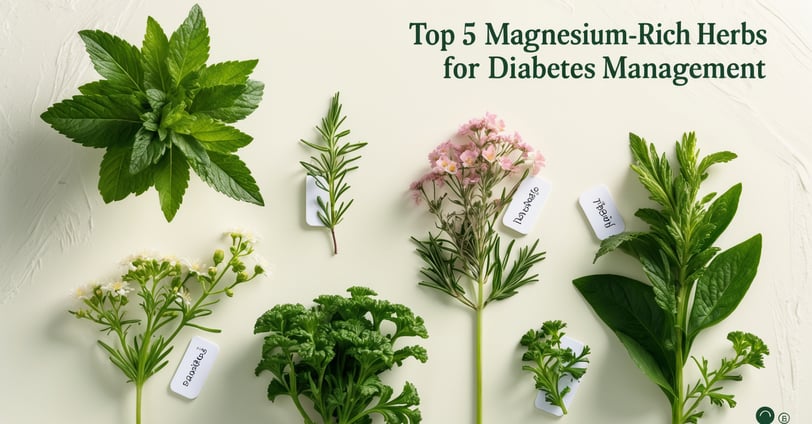Top 5 Magnesium-Rich Herbs for Diabetes Management 🌿
Top 5 Magnesium-Rich Herbs for Diabetes Management 🌿
Sophia Gold
8/14/20244 min read


Introduction: The Importance of Magnesium in Diabetes Management
Magnesium is an essential mineral that plays a crucial role in over 300 enzymatic reactions in the body, including those that regulate blood sugar levels, nerve function, and muscle health. For individuals managing diabetes, maintaining adequate magnesium levels is particularly important, as magnesium helps improve insulin sensitivity, reduce inflammation, and lower the risk of complications associated with diabetes. Incorporating magnesium-rich herbs into your diet is a natural way to boost your magnesium intake and support overall health. In this article, I’ll highlight the top five magnesium-rich herbs that can help you manage diabetes more effectively.
The Benefits of Magnesium for Diabetes
Magnesium offers several key benefits that are particularly helpful for individuals managing diabetes:
Key Benefits:
Improves Insulin Sensitivity: Magnesium helps the body use insulin more effectively, which is crucial for regulating blood sugar levels.
Reduces Inflammation: Magnesium has anti-inflammatory properties that help reduce chronic inflammation, which is often associated with insulin resistance and other diabetes-related complications.
Supports Heart Health: Magnesium helps regulate heart rhythm, lower blood pressure, and reduce the risk of cardiovascular diseases, which are common in individuals with diabetes.
Enhances Nerve Function: Magnesium supports proper nerve function and helps prevent or reduce symptoms of diabetic neuropathy.
Top 5 Magnesium-Rich Herbs
1. Basil (Ocimum basilicum)
What It Is:
Basil is a fragrant herb commonly used in culinary dishes. It is rich in magnesium, along with other vitamins and minerals that support overall health.
Benefits for Diabetes:
Basil’s magnesium content helps regulate blood sugar levels and improve insulin sensitivity. It also has anti-inflammatory properties, making it beneficial for reducing the risk of diabetes-related complications.
How to Use:
Basil Pesto: Blend fresh basil leaves with olive oil, garlic, pine nuts, and a touch of lemon juice to create a delicious pesto sauce. Use it as a spread, dressing, or pasta sauce.
Herbal Tea: Brew fresh basil leaves in hot water for a calming tea that provides a magnesium boost.
2. Parsley (Petroselinum crispum)
What It Is:
Parsley is a common herb used to garnish dishes, but it also packs a nutritional punch. It is rich in magnesium, as well as vitamins A, C, and K.
Benefits for Diabetes:
Parsley’s magnesium content supports blood sugar regulation and helps reduce inflammation. It’s also a natural diuretic, which can help manage blood pressure.
How to Use:
Parsley Salad: Add chopped parsley to salads, grain bowls, or as a topping for soups and stews to enhance flavor and nutrition.
Smoothies: Blend fresh parsley with fruits and vegetables for a nutrient-packed green smoothie.
3. Coriander (Coriandrum sativum)
What It Is:
Coriander, also known as cilantro, is an herb that is widely used in cooking for its distinctive flavor. It is a good source of magnesium and other essential nutrients.
Benefits for Diabetes:
Coriander’s magnesium content helps support insulin sensitivity and regulate blood sugar levels. It also has antioxidant properties that protect against oxidative stress.
How to Use:
Coriander Chutney: Blend fresh coriander leaves with green chilies, garlic, and lemon juice to create a flavorful chutney. Use it as a dip or spread.
Coriander-Infused Water: Soak coriander seeds overnight in water and drink the infused water in the morning for a refreshing and magnesium-rich start to your day.
4. Dill (Anethum graveolens)
What It Is:
Dill is a herb known for its feathery leaves and distinct flavor. It is a rich source of magnesium, as well as calcium and potassium.
Benefits for Diabetes:
Dill’s magnesium content helps regulate blood sugar levels and reduce inflammation. It also supports digestive health, which is important for overall well-being.
How to Use:
Dill Yogurt Dip: Mix fresh dill with Greek yogurt, garlic, and lemon juice to create a refreshing dip. Serve with raw vegetables or use as a sauce for grilled meats.
Dill-Infused Olive Oil: Infuse olive oil with fresh dill and use it as a dressing for salads or a marinade for fish.
5. Thyme (Thymus vulgaris)
What It Is:
Thyme is a versatile herb with a strong, earthy flavor. It is high in magnesium and has been used in traditional medicine for its health benefits.
Benefits for Diabetes:
Thyme’s magnesium content supports insulin function and helps maintain stable blood sugar levels. It also has antimicrobial and anti-inflammatory properties, which contribute to overall health.
How to Use:
Thyme Roasted Vegetables: Toss your favorite vegetables with olive oil, fresh thyme, and garlic, then roast until tender for a delicious side dish.
Herbal Tea: Brew thyme leaves in hot water for a soothing tea that provides a magnesium boost and supports digestion.
Conclusion: Incorporate Magnesium-Rich Herbs into Your Diabetes Management Plan
Magnesium is an essential mineral that plays a vital role in managing diabetes, supporting insulin function, reducing inflammation, and promoting overall health. By incorporating magnesium-rich herbs like basil, parsley, coriander, dill, and thyme into your diet, you can enhance your overall well-being and manage diabetes more effectively. These herbs not only provide essential nutrients but also offer a variety of flavors and culinary uses, making healthy eating both enjoyable and beneficial.
Resources for Further Reading:
Healthline: The Benefits of Magnesium for Health
National Institutes of Health (NIH): Magnesium and Diabetes Management


